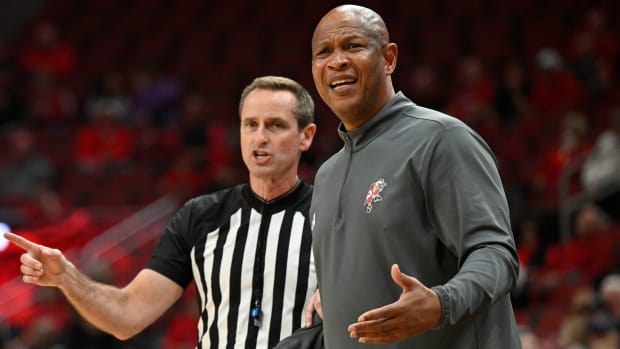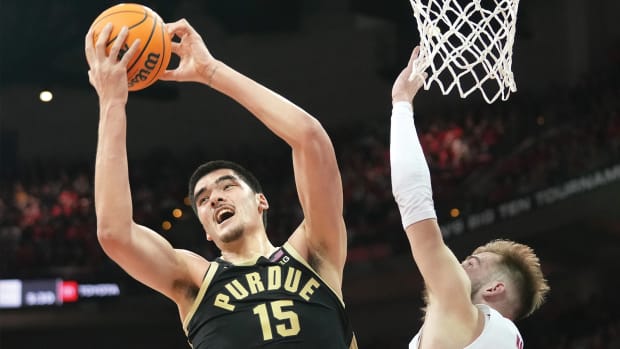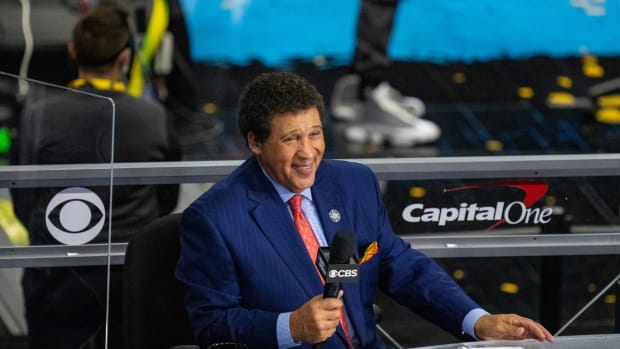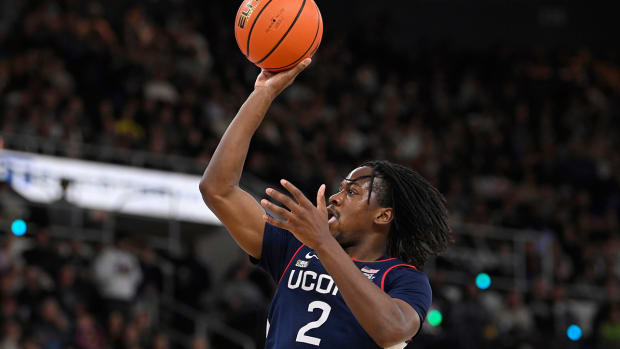As the NCAA Compensation Debate Rages, Transfer Rule Reform Now a Key Part of the Equation
WASHINGTON, D.C. — Last Tuesday, the NCAA stunned many in the college sports world by announcing a proposal to change a policy that dates back to the 1960s. Under the idea, first-time transfers in all sports would immediately be able to compete at their new school, rather than sit a year as they did under old legislation. Not only was the statement’s timing a surprise but so was its path: The proposal is being fast-tracked to go into effect this fall.
At least one conference administrator expressed surprise at the announcement and said his league received no warning. Meanwhile, Todd Berry, executive director of the American Football Coaches Association, a group opposed to the proposal, was completely “shocked” at the NCAA’s statement and said FBS conferences were against the idea as recently as last summer. “Something has happened recently,” Berry said. “I don’t know if it has to do with NIL or what.”
Many believe it does. Athlete compensation—otherwise known as name, image and likeness (NIL)—is at the heart of the matter, they believe. While the proposal is the latest in a long line of NCAA policy changes geared toward players’ rights, the timing suggests it may be a deliberate maneuver, possibly a concession, as part of the NCAA’s ongoing NIL battle here on Capitol Hill. Exactly a week after lawmakers in a hearing skewered NCAA president Mark Emmert over inequalities within his organization, the governing body appears to have shot a conciliatory flare over the Capitol.
“It’s hard to say, but I think it may be a very calculated step,” says Ramogi Huma, executive director of the National College Players Association and one of the more outspoken critics of the NCAA. “The Board of Governors has the ability to fast track issues deemed pertinent to NCAA sports. I think the NCAA is dragging its feet on NIL, but expediting this issue to show they are willing to compromise.”
It’s unclear whether the move will placate congressional leaders, the same ones Emmert and Co. are encouraging to create a federal bill to override state NIL laws. One high-ranking legislator, Sen. Cory Booker (D, N.J.), called the transfer proposal this week a “step in the right direction,” a potential sign of future changes that legislators described to Emmert in a hearing on Feb. 11. Senators took aim not only at “unfair” amateurism rules, but chastised Emmert for presiding over an antiquated structure that needs “far-reaching fundamental reform.” For some, the transfer proposal isn’t it.
“It feels a little bit disingenuous,” one athletic director told Sports Illustrated under condition of anonymity. “It seems like we’re trying to pacify or appease so people aren’t so hard on us with the NIL.”
So what now? While the NIL debate rages on in both college sports circles and in the halls of Congress, deliberation begins among conference decision-makers—school presidents and athletic directors—on whether to enact a transfer proposal with far-reaching complexities and unanswered questions.
Relaxing transfer rules is nothing new. The NCAA has adopted a slew of player-friendly transfer-related changes over the last two years. For instance, schools no longer have authority over a player’s transfer destination, a change that coincided with the creation of the transfer portal in fall of 2018. Graduating players can now play immediately after transferring within their own conference, and most schools release signees from their letters of intent if a head coach leaves a school before their first semester.
The latest change could reverse a long-standing rule adopted NCAA-wide in the early 1960s, one that originated more than a century ago when a group of Ivy League schools agreed to a one-year sit-out provision for players transferring among them. But even this isn’t so new. About 15 years ago, the Mountain West proposed the exact thing—only to see it voted down in an NCAA committee.
Most administrators are seeking a unified rule for all sports. Under the current policy, players can transfer freely and play immediately in all sports except for baseball, men's and women's basketball, football and men’s ice hockey. The Big Ten and ACC have expressed support for the change. In fact, the Big Ten originally made the proposal over the fall. However, the conference also presented a second proposal that calls for players in every sport to sit out a year after transferring. “I understand why the Big Ten put that out,” says Texas athletic director Chris Del Conte. “They put up a proposal that everyone sit a year or everyone has a one-time transfer. It’s creating national dialogue.”
While many administrators agree to wanting a unified transfer rule, they admit to varying degrees of concern, most of them stemming from an anticipated spike in transfers. Without a one-year penalty, players will be more inclined to leave. Academic Progress Rate scores could see such a dip that many believe the formula would need an adjustment. Under current APR formula, each player earns one point for staying in school and one point for being academically eligible. Transferring players would cost a school the retention point. Florida athletic director Scott Stricklin suggests the APR either begin accounting for transfers as it might for players turning pro or APR benchmarks be adjusted to reflect the transfer rule change.
Meanwhile, Del Conte warns of potential mass exoduses, the original reason for the exceptions in football, basketball, baseball and hockey. “Everything comes back. Hell, it’s like bell bottoms—they’re coming back,” Del Conte says. “We’ve created these exceptions within the rules. The dam has broken. We have no one to blame but ourselves, the membership. The NCAA is made up of us. We make the rules. We vote on the rules. The staff at NCAA enforces the rules that we make up.”
The threat of mass transfers could actually be a positive, says another athletic administrator. “It’s going to make a coach have a relationship with your guys. You’re an asshole? You’re in trouble,” says the administrator, who wished to remain anonymous. “Some of these guys make a lot of money and forget what it’s about. Got to pay attention to your kids. You’ve got to build a relationship with a kid, not lying and bulls------- them. You’re going to see now who are the good guys and the bad guys.”
In the proposal, transfers can only receive immediate eligibility if they meet four conditions: 1) receive a release from their previous school; 2) leave their previous school academically eligible; 3) maintain their academic progress at their new school; and 4) leave under no disciplinary suspension. The first of these begs a question: Will schools again start blocking transfers, this time from immediate eligibility? And what about inner-conference transfers? Many SEC athletic administrators believe the league would never allow such.
Meanwhile, Stricklin wonders aloud regarding a deadline in which players must decide to transfer in order to play immediately. The deadline could be different for each sport and must be some reasonable period prior to the start of the season to prevent midseason transfers. Imagine a football player leaving after preseason camp—before the academic semester begins—and being eligible to play the next week at another FBS program. “You’ve got to do something that works for every sport,” Stricklin says. “Maybe it’s a date for each or so many weeks before the start.”
Some administrators believe true freshmen should be an exception to this new change. First-year players, one suggested, must remain enrolled for a full year before having the one-year sit-out provision waived. The first year in college is often the toughest. Freshmen might make rash, regrettable decisions to leave. Coaches have the concern, too. “I’ve heard other coaches say that they’ve had kids transfer and then the kids call them three months later and say ‘Coach, I made a terrible mistake. I was emotional at the time,’” Berry says. “We don’t want to see that.”
Roster poaching is a top concern for coaches. Some Group of Five coaches have expressed a fear that Power 5 assistants will recruit their best players, but it works both ways, says Bryan Maggard, a former Missouri administrator who’s now athletic director at Louisiana, a Sun Belt school. “It could happen in the reverse,” Maggard says. “A Power 5 student-athlete not getting the playing time might find it beneficial to drop down a level. Don’t know it would be a huge advantage or disadvantage. Time will tell.”
Coaches and administrators can all at least agree on one thing: They hope this streamlines a convoluted waiver process that caused a stir last year when high-profile quarterbacks Tate Martell and Justin Field were somewhat surprisingly granted immediate eligibility at their new schools while other less notable players were denied.
Meanwhile, the debate over athlete compensation rages on across the U.S., as more than 20 states are debating NIL legislation. On Capitol Hill, the fight is beginning its stretch run toward a sentinel moment in April, when the NCAA is expected to release its proposed NIL reform. The transfer proposal is but a ripple in a tidal wave of reform speeding across the NCAA ocean. “That train has left the station,” says one SEC administrator. “The world as we know it is changing. And it’s changing fast.”




